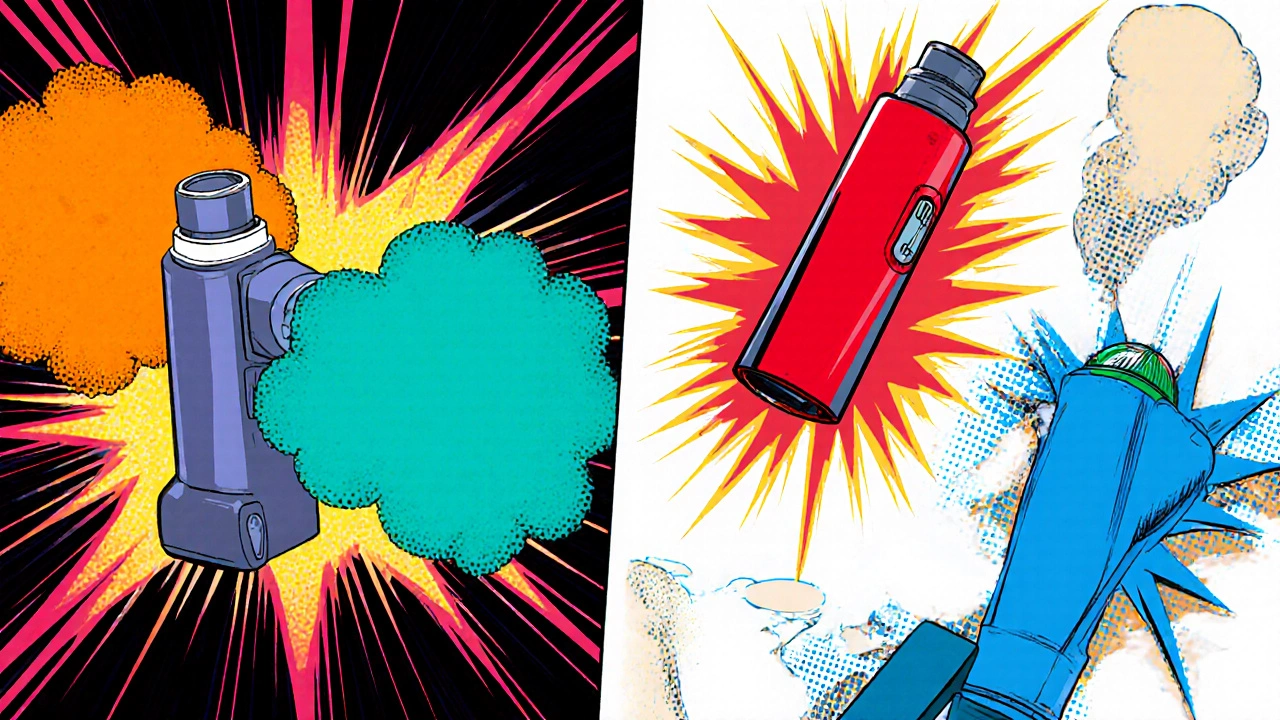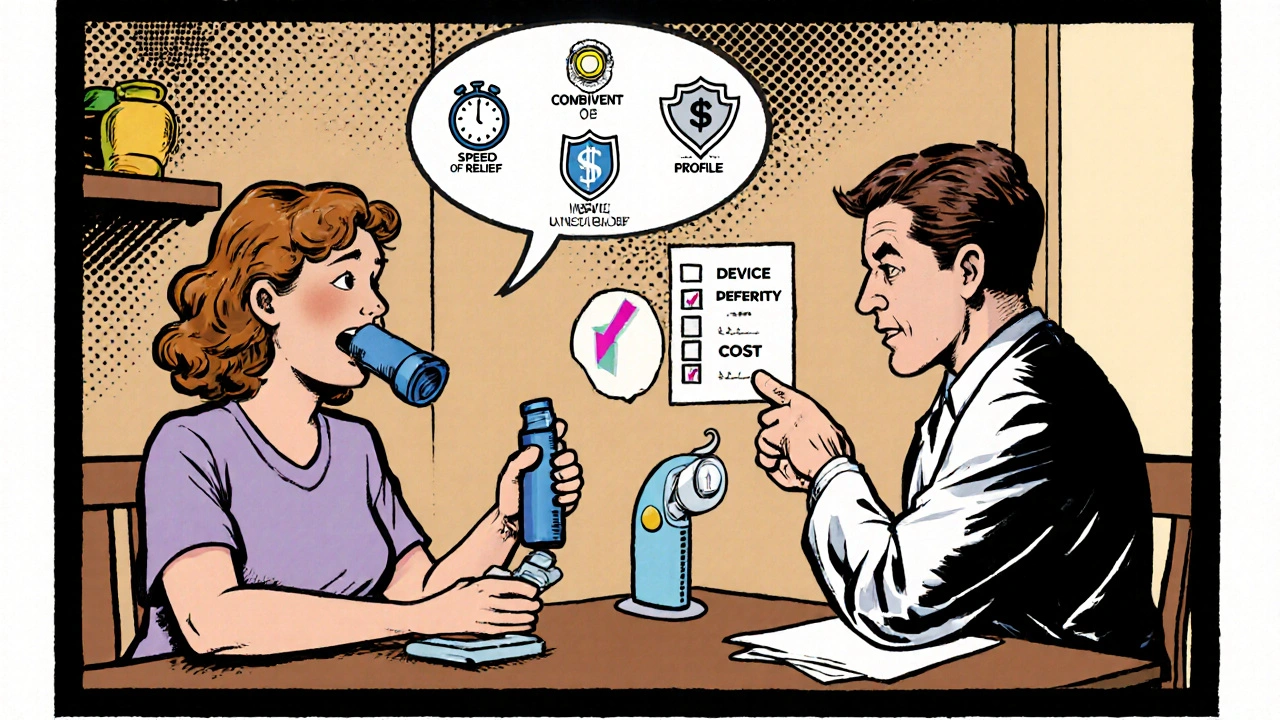Inhaler Decision Guide
Inhaler Decision Guide
Find the best inhaler option based on your symptoms, COPD severity, and personal preferences.
When you’ve got shortness of breath or a sudden asthma flare, the inhaler you choose can make a big difference. Combivent alternatives are a hot topic for anyone managing COPD or asthma, because the market now offers a mix of single‑drug and combo products, nebulizer solutions, and newer long‑acting options. This article breaks down how Combivent works, walks through the most common substitutes, and gives you a side‑by‑side look so you can decide whether to stay with Combivent or switch.
What is Combivent?
Combivent is a brand‑name inhaler that combines two bronchodilators-albuterol (a short‑acting beta‑agonist) and ipratropium (a short‑acting anticholinergic)-delivered via a metered‑dose inhaler (MDI). The dual action opens airways quickly: albuterol relaxes the airway smooth muscle, while ipratropium blocks a different pathway that can cause bronchoconstriction. The result is a faster, more complete relief for patients who don’t get enough benefit from a single agent.
How Combivent Works
The albuterol component activates β2‑adrenergic receptors, causing the muscle around the airways to relax within minutes. Ipratropium blocks muscarinic receptors, preventing acetylcholine‑driven tightening of the same muscles. Together, they produce a broader bronchodilation effect, especially useful for severe COPD exacerbations or asthma that’s refractory to albuterol alone.
Common Alternatives to Combivent
Below are the most frequently discussed substitutes. Each entry introduces the product with a brief definition and highlights the key differences from Combivent.
- Ventolin is a single‑agent inhaler that contains only albuterol, marketed as a rescue inhaler for quick relief of asthma symptoms. It’s inexpensive and widely available but lacks the anticholinergic boost that ipratropium provides.
- Atrovent is a stand‑alone ipratropium inhaler, primarily used in COPD to reduce mucus secretion and prevent bronchoconstriction. It works slower than albuterol and is rarely used alone for acute asthma attacks.
- DuoNeb is a nebulized solution that also mixes albuterol and ipratropium, delivering the combo via a machine rather than an MDI. Ideal for patients who have trouble using inhalers correctly, though it requires a power source and longer treatment time.
- ProAir HFA is a rapid‑acting albuterol inhaler, similar to Ventolin but with a different propellant that many patients find easier to inhale. No anticholinergic component.
- Spiriva is a once‑daily long‑acting anticholinergic (tiotropium) inhaler, used for maintenance therapy in COPD. Not a rescue medication but can reduce the need for short‑acting combos.
- Symbicort is a combo inhaler that pairs a long‑acting beta‑agonist (formoterol) with an inhaled steroid (budesonide). Targets both inflammation and bronchodilation, but its onset is slower than albuterol‑based rescue inhalers.

Side‑by‑Side Comparison
| Product | Components | Delivery Form | Onset (min) | Duration (hrs) | Typical Use |
|---|---|---|---|---|---|
| Combivent | Albuterol+Ipratropium | Metered‑dose inhaler (MDI) | 5-10 | 4-6 | Acute COPD or asthma exacerbations |
| Ventolin | Albuterol only | MDI | 5-10 | 4-5 | Rescue for asthma |
| Atrovent | Ipratropium only | MDI | 10-15 | 4-6 | Maintenance for COPD |
| DuoNeb | Albuterol+Ipratropium | Nebulizer solution | 7-12 (during nebulization) | 4-6 | Hospital or home nebulizer use |
| ProAir HFA | Albuterol only | MDI | 5-10 | 4-5 | Rescue for asthma/COPD |
| Spiriva | Tiotropium (LAMA) | Dry‑powder inhaler | 30-60 | 24+ | Daily COPD maintenance |
| Symbicort | Formoterol+Budesonide | MDI | 5-10 (formoterol) | 12 | Maintenance for asthma & COPD |
Choosing Between Combivent and Its Alternatives
Here are the practical factors that most patients weigh when deciding whether to stick with Combivent or switch.
- Speed of relief. If you need the fastest possible opening of airways, the albuterol‑only inhalers (Ventolin, ProAir) work just as quickly as Combivent. The added ipratropium doesn’t speed onset; it extends the overall bronchodilation window.
- Severity of COPD. For moderate‑to‑severe COPD where mucus and cholinergic tone play a big role, the combo (Combivent or DuoNeb) often outperforms albuterol alone. In milder disease, a single bronchodilator may be sufficient.
- Device preference. Some patients struggle with the hand‑breath coordination required for MDIs. A nebulizer (DuoNeb) eliminates that step, but it ties you to a power source and longer treatment sessions.
- Insurance coverage and cost. Combo inhalers tend to be pricier than single‑agent products. Check your pharmacy benefits; many plans place Combivent in a higher tier, while generic albuterol or ipratropium inhalers sit in a lower tier.
- Side‑effect profile. Adding ipratropium can increase dry mouth or throat irritation. If you experience these bothersome effects, a single‑agent albuterol may feel more comfortable.
- Long‑term management goals. If you’re already on a maintenance LAMA like Spiriva, you might reserve Combivent for occasional rescue use and rely on your daily medication for baseline control.

Tips for Switching Safely
Changing inhalers isn’t just a swap in the medicine cabinet; it involves technique, timing, and sometimes a brief titration period.
- Consult your prescriber. They can confirm that the new device delivers the right dose for your condition.
- Practice the inhaler technique with a spacer or holding chamber if you’re moving from a nebulizer to an MDI. Proper coordination improves drug delivery by up to 40%.
- Keep a short‑acting rescue inhaler (like Ventolin) on hand for the first 48hours after the switch. This safety net helps you gauge whether the new regimen provides adequate relief.
- Track your symptoms in a simple log-note peak flow readings, nighttime awakenings, and rescue inhaler use. If you see a clear worsening, contact your clinician.
- Check refill dates and insurance authorizations before the old inhaler runs out. Avoid gaps in therapy that could trigger an exacerbation.
Frequently Asked Questions
Is Combivent better than using albuterol and ipratropium separately?
Combivent delivers the exact same dose of both drugs in a single puff, which simplifies dosing and improves adherence. Clinical studies show comparable bronchodilation to taking the two inhalers back‑to‑back, but with fewer mistakes in timing.
Can I use a nebulizer like DuoNeb instead of Combivent?
Yes, DuoNeb provides the same drug combo in a nebulized form. It’s a good choice if you have coordination difficulties, but it takes 5-10 minutes per treatment and requires a power source, making it less convenient for on‑the‑go rescue.
What are the main side effects of Combivent?
Common side effects include tremor, rapid heart rate, dry mouth, and throat irritation. The ipratropium component is mainly responsible for the dryness, while albuterol can cause jitteriness.
Is Combivent covered by Medicare Part D?
Most Medicare plans include Combivent, but it’s typically placed in a higher cost‑share tier. You may need to meet a deductible before the medication is covered. Check your plan’s formulary for exact copay amounts.
Can I use Combivent with a maintenance inhaler like Spiriva?
Absolutely. Combivent is a rescue medication, while Spiriva is taken once daily for long‑term control. Using them together follows standard COPD management guidelines.
How often can I safely use Combivent?
The usual recommendation is no more than 2puffs every 4hours, and not more than 12puffs in a 24‑hour period. Exceeding that can raise the risk of heart palpitations and low potassium levels.
Whether you stay with Combivent or move to one of its alternatives, the key is matching the inhaler’s speed, convenience, and side‑effect profile to your daily life and disease severity. Keep a symptom journal, stay in touch with your healthcare team, and don’t let insurance lingo dictate your health-ask for a formulary exception if a cheaper alternative works just as well for you.


Combivent feels like a hidden agenda from pharma giants 😐
Everyone thinks the combo inhaler is a miracle, but honestly it’s just a marketing stunt that ignores real patient needs. I’ve seen people switch to generic albuterol and wonder why they even bother with the pricey combo. The drama of “new and better” is just a sales trick, trust me.
Okay, so maybe the “big pharma” is pulling strings, but at the end of the day you just need something that opens your lungs fast. I tried the DuoNeb once and it felt like a circus of tubes, not really my style. A single Ventolin puff does the trick for my occasional wheeze. If you’re scared of dry mouth, just sip water, no big deal.
When contemplating the optimal rescue inhaler, one must first acknowledge the delicate balance between pharmacologic efficacy and user ergonomics. The albuterol‑ipratropium duet delivers a broader bronchodilatory spectrum, yet its true advantage lies in patient adherence, since a single actuation replaces the need for sequential dosing. Imagine a scenario where a COPD exacerbation strikes suddenly; the ability to inhale two agents simultaneously can shave precious minutes off the relief timeline. However, the marginal gain in onset speed is debatable, as albuterol alone already provides rapid relief within five minutes. The added anticholinergic component primarily extends the duration, which may be beneficial for those with persistent bronchospasm. From a physiological standpoint, the synergy between β2‑agonism and muscarinic blockade mitigates both sympathetic and parasympathetic bronchoconstrictive pathways. Yet, this synergy is not a panacea; patients with mild asthma may find the extra anticholinergic activity unnecessary and potentially irritating. Side‑effects such as dry mouth and tremor are more pronounced when both agents coexist, demanding a trade‑off analysis. Moreover, the cost factor cannot be ignored-combo inhalers often sit in a higher tier of insurance formularies, nudging patients toward cheaper monotherapy options. In clinical practice, I have observed that many individuals achieve comparable control with a well‑timed albuterol puff and a maintenance LAMA, reserving the combo for severe episodes only. The nebulized alternative, while eliminating coordination challenges, imposes a burden of time and equipment, making it less appealing for on‑the‑go situations. Technological advancements in dry‑powder inhalers may soon blur these distinctions further, offering multi‑dose formulations with improved delivery efficiency. Until such innovations become mainstream, the decision rests on personal preference, disease severity, and financial considerations. In summary, Combivent is a valuable tool in the therapeutic arsenal, but it is not universally superior to its constituents used separately. Choose wisely, weigh the pros and cons, and maintain open dialogue with your healthcare provider.
The idea that every patient needs the combo is a myth perpetuated by those who profit from repeat prescriptions. If you can master your inhaler technique, a single-agent spray often suffices for mild attacks. Keep an eye on your symptom diary before you jump on the pricey combo bandwagon.
Let’s be clear: empowering patients starts with education, not with blanket prescriptions for the most expensive product. I’ve coached countless individuals to assess their own peak flow trends and adjust therapy accordingly. When you understand the nuances between short‑acting β‑agonists and anticholinergics, you can tailor treatment without fear. Remember, a supportive clinician will help you navigate insurance hurdles rather than push a one‑size‑fits‑all solution. This approach fosters confidence and better long‑term outcomes.
Indeed, the process of individualized care, which necessitates thorough patient history, diligent monitoring of lung function, and careful consideration of pharmacoeconomic factors, should be the cornerstone of respiratory management; consequently, clinicians are urged, wherever possible, to engage in shared decision‑making, to mitigate the risk of unnecessary medication escalation, and to promote adherence through transparent communication.
While dramatic narratives may capture attention, the clinical data supporting combination therapy remains robust, particularly for patients with severe COPD exacerbations. A measured, evidence‑based approach supersedes anecdotal criticism.
Hey there! I get the suspicion, but sometimes the combo really does help when a single puff just isn’t enough. Give it a try, track how you feel, and decide if the extra boost is worth it for you.